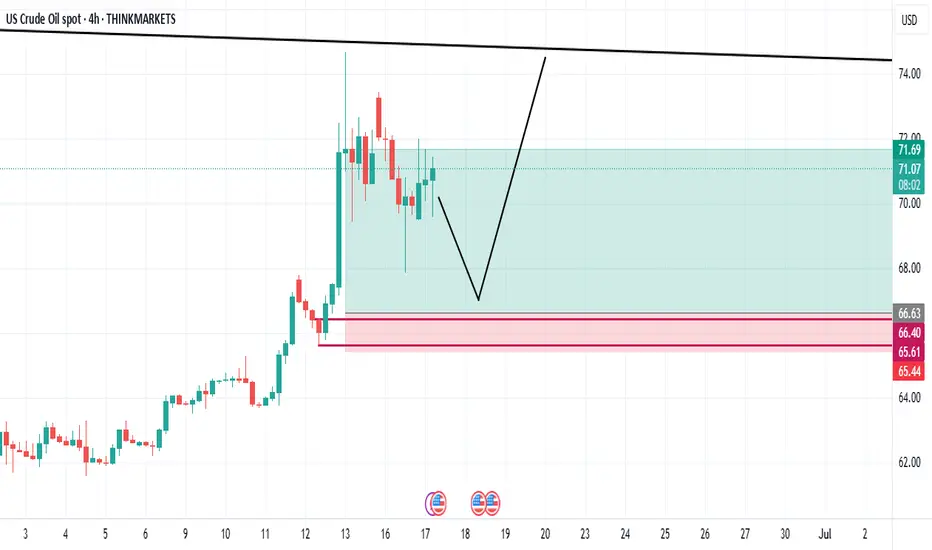The WTI Crude Oil (US Oil Spot) chart shows price action still trading within a long-term descending channel, bounded by dynamic resistance and support dating back to mid-2022. Currently, price has bounced strongly off the $67–$58 demand zone, rallying toward the descending trendline around $76–$78, which also aligns with key historical supply levels. This area poses a significant challenge for bulls and may trigger short-term rejection. However, the recent impulsive bullish leg suggests renewed demand, possibly driven by geopolitical uncertainty and speculation of potential supply disruption.
From a Smart Money Concept (SMC) perspective, WTI recently swept liquidity below the $58.69 low and formed a bullish Change of Character (ChoCH) as price broke through short-term structure levels. This confirms that smart money may have accumulated long positions in the discount zone. The rally targeting the $76.77–$78.30 range appears to be part of a mitigation move toward a supply zone, and traders may anticipate either a reversal or continuation depending on how price reacts near that level.
Macro & Geopolitical Context:
This bullish momentum in crude oil comes amid elevated tension between Iran and Israel, which historically injects volatility into energy markets. Any escalation could threaten oil production or export routes in the Middle East, particularly the Strait of Hormuz, through which a significant percentage of global oil supply flows. Such events can drive speculative and fundamental buying in oil, pushing prices higher in anticipation of reduced supply. However, oil traders must also remain aware of OPEC+ policy decisions and U.S. inventory data, which can quickly shift sentiment.
Trade Outlook:
Alternative View: Strong rejection at the descending trendline may result in a return to the $67 or even $58 support if risk-off sentiment declines or supply concerns ease.
In summary, oil is currently reacting to both technical and geopolitical catalysts. While the technical structure suggests a short- to medium-term bullish move toward the upper channel resistance, sustained upside will depend heavily on how the Iran–Israel conflict unfolds, and whether market participants anticipate further disruptions to global oil supply.
From a Smart Money Concept (SMC) perspective, WTI recently swept liquidity below the $58.69 low and formed a bullish Change of Character (ChoCH) as price broke through short-term structure levels. This confirms that smart money may have accumulated long positions in the discount zone. The rally targeting the $76.77–$78.30 range appears to be part of a mitigation move toward a supply zone, and traders may anticipate either a reversal or continuation depending on how price reacts near that level.
Macro & Geopolitical Context:
This bullish momentum in crude oil comes amid elevated tension between Iran and Israel, which historically injects volatility into energy markets. Any escalation could threaten oil production or export routes in the Middle East, particularly the Strait of Hormuz, through which a significant percentage of global oil supply flows. Such events can drive speculative and fundamental buying in oil, pushing prices higher in anticipation of reduced supply. However, oil traders must also remain aware of OPEC+ policy decisions and U.S. inventory data, which can quickly shift sentiment.
Trade Outlook:
- Bias: Bullish until $76–$78 zone; watch for rejection or breakout.
- Entry: Pullback entries between $70–$71 with bullish confirmation are ideal.
- Stop Loss: Below $66 or invalidation at $64 (below structure support).
- Take Profit: Conservative TP around $76.77; extended target at $78.30–$79.37.
Alternative View: Strong rejection at the descending trendline may result in a return to the $67 or even $58 support if risk-off sentiment declines or supply concerns ease.
In summary, oil is currently reacting to both technical and geopolitical catalysts. While the technical structure suggests a short- to medium-term bullish move toward the upper channel resistance, sustained upside will depend heavily on how the Iran–Israel conflict unfolds, and whether market participants anticipate further disruptions to global oil supply.
Disclaimer
The information and publications are not meant to be, and do not constitute, financial, investment, trading, or other types of advice or recommendations supplied or endorsed by TradingView. Read more in the Terms of Use.
Disclaimer
The information and publications are not meant to be, and do not constitute, financial, investment, trading, or other types of advice or recommendations supplied or endorsed by TradingView. Read more in the Terms of Use.
